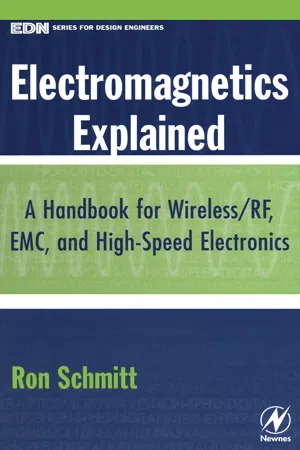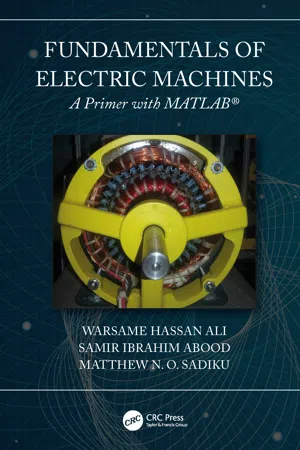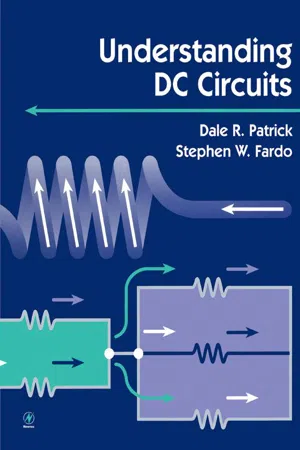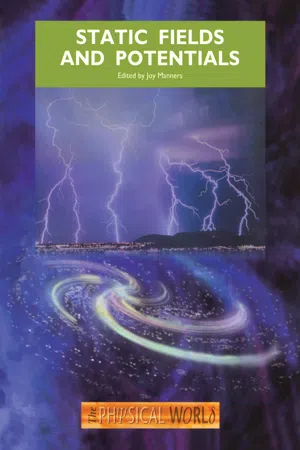Physics
Current to Magnetic Field
Current to magnetic field refers to the relationship between an electric current and the magnetic field it generates. When an electric current flows through a conductor, it creates a magnetic field around the conductor. This phenomenon is described by Ampère's law and is fundamental to understanding electromagnetism and the behavior of electric currents in various devices and systems.
Written by Perlego with AI-assistance
Related key terms
Related key terms
1 of 4
Related key terms
1 of 3
6 Key excerpts on "Current to Magnetic Field"
- eBook - ePub
Electromagnetics Explained
A Handbook for Wireless/ RF, EMC, and High-Speed Electronics
- Ron Schmitt(Author)
- 2002(Publication Date)
- Newnes(Publisher)
In fact, all magnetic fields are generated indirectly by moving electric charges. It is a fundamental fact of nature that moving electrons, as well as any other charges, produce a magnetic field when in motion. Electrical currents in wires also produce magnetic fields because a current is basically the collective movement of a large number of electrons. A steady (DC) current through a wire produces a magnetic field that encircles the wire, as shown in Figure 3.1. Figure 3.1 Magnetic field lines surrounding a current-carrying wire. A single charge moving at constant velocity also produces a tubular magnetic field that encircles the charge, as shown in Figure 3.2. However, the field of a single charge decays along the axis of propagation, with the maximum field occurring in the neighborhood of the charge. The law that describes the field is called the Biot-Savart law, named after the two French scientists who discovered it. Figure 3.2 Magnetic field lines surround a moving electron. It is interesting to note that if you were to move along at the same velocity as the charge, the magnetic field would disappear. In that frame of reference, the charge is stationary, producing only an electric field. Therefore, the magnetic field is a relative quantity. This odd situation hints at the deep relationship between Einstein’s relativity and electromagnetics, which you will learn about in detail in Chapter 6. The magnetic field direction, clockwise or counterclockwise, depends on which direction the current flows. You can use the “right hand rule” for determining the magnetic field direction. Using Figure 3.3 as a guide, extend your hand flat and point your thumb in the direction of the current (i.e., current is defined as the flow of positive charge, which is opposite to the flow of electrons). Now curl the rest of your fingers to form a semicircle - David V. Guerra(Author)
- 2023(Publication Date)
- CRC Press(Publisher)
) . Thus, it is electrical currents that “feel” magnetic forces.6.3.2 Example of Computing a Magnetic Force on a Current-Carrying Wire
Compute the magnitude and direction of the force on a 12 cm long wire carrying 3.0 A of current in the +x-direction in a region with a constant magnetic field of 4.0 × 10−7 T in the +z-direction.Solution:- Step 1: As shown in Figure 6.10 , sketch the diagram paying close attention to the directions of the current and the magnetic field.
The dots represent the magnetic field coming out of the page in the +z-direction and the current is moving to the right in the +x-direction.FIGURE 6.10 Example of the magnetic force on a current-carrying wire.
- Step 2: Compute the magnitude of the magnetic force on the current-carrying wire with equation (6.2),
F = B I L s i n ( θ )F = B I L sin( θ )=(4.0 ×)10T− 7(3.0 A)(= 1.4 ×12 m)10N− 7
- Step 3: Use the RHR to find the direction of the magnetic force on the current-carrying wire and draw the force vector on the diagram. Notice that the x- and z-components of the force are zero and the magnetic force on the current-carrying wire is in the –y-direction.
F x= 0 ,F y= − 1.4 ×10N ,− 7F z= 0
6.4 Magnetic Force on a Moving Charged Particle
As demonstrated in Figure 6.11 , an electrical current can be thought of as the flow of electrical charge moving through a wire. If this wire is in a magnetic field, the force due to the magnetic field can be thought of as acting on the individual charges moving at a given speed.FIGURE 6.11 Positively charged particle moving through a wire in a magnetic field.Given that the force due the magnetic field isF = B I L sin ( θ )and the electrical current is the flow rate of electric charge,I =Δ qΔ t- eBook - ePub
Fundamentals of Electric Machines: A Primer with MATLAB
A Primer with MATLAB
- Warsame Hassan Ali, Matthew N. O. Sadiku, Samir Abood(Authors)
- 2019(Publication Date)
- CRC Press(Publisher)
The value of the force increases when the value of any amount on the right side of the equation increases. The length is also increased when making the conductor in the shape of a coil inside the magnetic field and often design the coil in the form of a frame that has two sides and when placed within the external magnetic field and make it moves freely around the axis, this carrier of the current will start circling around the axis. Because the direction of the upper and lower forces is one, the direction of the frame is identical to the clockwise movement. When the current is changed in the coil or the polarity of the external magnetic field changes, the direction of the frame rotation will be reversed. This phenomenon is one of the most important principles of the utilization of the transformation of electric energy into the kinetic energy of electric motors.When the direction of the conductor movement within the magnetic field at a certain angle (θ), with the direction of the lines of the magnetic forces of this field, the expression of force becomes:f = B ∗ i ∗ L ∗ s i n θ ,(1.4) where: L distance of moving current i. The magnetic field affects the moving charge (Q) and the charge generates a moving current for a distance (L) in time (T) within the field, and the direction of the movement of the charge is at an angle (θ), the expression of force becomes:f = B ∗ Q ∗ V ∗ s i n θ .(1.5) Example 1.2 When a 20 cm conductor is passed in which a current of 20 A is within a magnetic field, the force exerted on the conductor is 24 N. What is the density of the lines of this field?1.12 Hysteresis LoopSolutionThe density of the field lines or the density of the magnetic flux is:B = f/IL = 2.4 / ( 20 × 20 ×10)− 2= 0.6 Wb/m 2.The (B-H) curve basically emphasizes the flux intensity and field strength of the material with additionally expresses the relationship between magnetic and non-magnetic materials and describes the former condition of it. The curve mentioned the relationship of a magnetic equation of the magnetizing and demagnetizing experiences which is drawn by a closed loop. In fact, it is also known as the most essential characteristics that represent the relationship of the field-density (B-H) of the material. It experiences a condition of material before the method of heat treatment and mechanical tension. - eBook - ePub
- Dale Patrick, Stephen Fardo(Authors)
- 1999(Publication Date)
- Newnes(Publisher)
This produces a magnetic field because of electric charge movement. Figure 4-12 shows the arrangement of domains in magnetic, nonmagnetic, and partially magnetized materials. In nonmagnetic materials, half the electrons spin in one direction and half spin in the opposite direction. Their charges cancel each other out. No magnetic field is produced because the charges cancel. In magnetic materials electrons rotate in the same direction. This causes the domains to act like tiny magnets that align to produce a magnetic field. Figure 4-12 Domain theory of magnetism, (a) Unmagnetized, (b) Slightly magnetized, (c) Fully magnetized saturation. Electricity Produced by Magnetism A scientist named Michael Faraday discovered in the early 1830s that electricity is produced by magnetism. He found that if a magnet is placed inside a coil of wire, electric current is produced when the magnet is moved. Faraday found that electric current is produced by magnetism and motion. Faraday’s law is stated as follows: When a coil of wire moves across the lines of force of a magnetic field, electrons flow through the wire in one direction. When the coil of wire moves across the magnetic lines of force in the opposite direction, electrons flow through the wire in the opposite direction. This law is the principle of electric power generation produced by magnetism. Figure 4-13 shows Faraday’s law as it relates to electric power generation. Figure 4-13 Faraday’s law. Electric current is produced when there is relative motion between a conductor and a magnetic field. Current flows in a conductor placed inside a magnetic field only when there is motion between the conductor and the magnetic field. If a conductor is stopped while it is moving across the magnetic lines of force, current stops flowing. The operation of electric generators depends on conductors moving across a magnetic field - eBook - ePub
- Joy Manners(Author)
- 2020(Publication Date)
- CRC Press(Publisher)
r), the weaker the magnetic field.Notice that in Equation 4.4, the field strength has been written as B(r) instead of B(r). This is because in this case the field strength at any point is determined entirely by its perpendicular distance r from the wire. This simplification occurs because the field produced by the wire is highly symmetrical. If you imagine a set of coaxial cylinders drawn around the wire, as shown in Figure 4.26 , the field strength has the same value at all points on any one of the cylinders. However, the field strength is different on each of the different cylinders. So, for a given current i, the value of B at any point is determined by the cylinder upon which the point lies, and the simplest way of specifying the cylinder is to quote the appropriate value of its radius r. Another notational point concerns the current i. For simplicity, and to avoid the unnecessary use of modulus signs, it will be assumed throughout this chapter that the direction of i is known (or can be chosen) and that i is a positive quantity.Figure 4.26 Imaginary cylindrical surfaces surrounding the current. The strength of the magnetic field is the same at all points on any given cylinder.The constant is called the permeability of free space. It is frequently encountered in electromagnetism just as ɛ0 is common in electrostatics. We can see from Equation 4.4 that, if i is measured in amps, B is measured in teslas and r is measured in metres, then the units of μ0 are T m A−1 . The value of μ0 - eBook - ePub
- Donald W. McRobbie(Author)
- 2020(Publication Date)
- Wiley-Blackwell(Publisher)
Hall effect.Lorentz force
The magnitude of the Lorentz force on a charge Q possessing velocity v is given as(2.20)The direction of the force can be determined by Fleming’s left‐hand rule.Magneto‐hydrodynamic effect
A similar effect is the generation of an electric field E by the flow of charge within an external magnetic field (Figure 2.26 ). This is analogous to the Hall effect observed in semiconductors.(2.21)Magneto‐hydrodynamic and Hall effect.Figure 2.26In terms of induced voltage or electrical potential, V, where(2.22)and d is the distance between charged surfaces (as in a capacitor), we have an induced voltage(2.23)The effect is most commonly encountered in MRI as an artefact in ECG traces.LAWS OF INDUCTION
The laws of induction follow from Maxwell’s third equation or Faraday’s law. If we consider a wire loop within a time‐varying B‐field the magnitude of the induced E‐field is [3 ](2.24)This applies for both the electric field induced by the imaging gradients responsible for peripheral nerve stimulation (PNS), and the electric field induced by the RF B1 ‐field responsible for SAR and tissue (and implant) heating. The direction of E follows a left‐hand rule, as any magnetic field produced by the induced current in the wire opposes the rate of change of flux that induced it.Faraday induction from the gradients
Biological tissues conduct electricity by means of water and electrolytes. Rather than considering electrical current in tissue (as in wires), we consider the current densityJ, a vector (Figure 2.27 )(2.25)Ohm’s law in a circuit and a volume conductor.Figure 2.27σ is the tissue conductivity in siemens per meter (S m−1 ). Some representative values are shown in Table 2.3 .Tissue conductivity at various frequencies. Electrical properties from https://itis.swiss/virtual‐population/tissue‐properties/databaseTable 2.3
Index pages curate the most relevant extracts from our library of academic textbooks. They’ve been created using an in-house natural language model (NLM), each adding context and meaning to key research topics.
Explore more topic indexes
Explore more topic indexes
1 of 6
Explore more topic indexes
1 of 4





